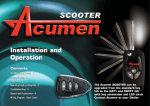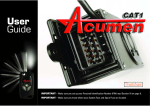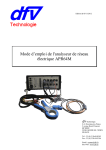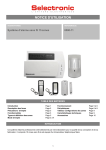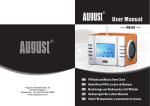Download CAT3-1 User Guide Nov 06.qxp
Transcript
Installation and Wiring The Acumen CAT3.1 consists of the following main components; • CAT3.1 main unit ECU (Electronic Control Unit) • CAT3.1 wiring harness • 1 x Remote Fob • Fitting kit including System fuse, spare fuse & Blue LED system indicator Tool Required: • • • • • • • • • Pliers/Cable strippers/Cable cutters Drill with 5.5mm and 8mm bits Soldering equipment Adhesive lines heatshrink tubing High quality insulating tape Masking tape (for drilling LED hole) Multimeter General workshop tools Motorcycle wiring diagram CAT3.1 main unit ECU (Electronic Control Unit) Ensure the fitting of the equipment and the associated wiring does not affect the operation of the motorcycle. Be sure the alarm and wiring does not affect moving parts (such as control cables, brakes) and does not touch hot parts. Siting/positioning the CAT3.1 main unit/ECU (Electronic Control unit) When mounting the unit, use the 5mm screws/nuts supplied in the fitting kit or cable tie the unit to a suitable frame tube. Take care to mount the unit where access to it is protected (the more difficult it is to reach, the harder the job the ‘thief’ has to bypass the alarm). Route the wiring alongside the motorcycle wiring, and tape it in the style of the original motorcycle wiring. Siting/positioning the LED system Indicator Be aware the LED will result in a small increase of electrical current drain. The LED draws 1mA of electrical current. The LED provides a visual indication of the alarm’s status, helps with the diagnostic mode of the alarm, and will warn a potential thief that your motorcycle is alarmed and that the alarm is armed. For this reason, it is preferable to position the LED where it can be easily seen. Having decided on a suitable position, drill an 8mm hole, pass the LED through from the back of the hole and then insert the LED into the LED holder. Then push the LED holder back into the 8mm hole to mount it securely. Route the LED wires to the position of the CAT3.1 ECU. The alarm has a loom which ends in a 6-way connector. This connector connects to the wiring loom which is connected to the motorcycle. Movement Sensor Mount the movement sensor so the wire is vertical +/- 30 degrees. No other setting or adjustment is required. The nearer the centre of the bike laterally, the less sensitive it is. Mount the movement sensor so the wire is vertical The CAT3.1 is designed for motorcycle use and is fully encapsulated so water ingress is not of a concern. Likewise, the Key Fob is also of a waterproof design. We recommend however that the unit is not placed in a position where it is continually subjected to water and/or pressure washing. 1 Installation and Wiring To make the alarm active, you only need to connect the Red, Black and Brown wires Connect the system wires as follows: A larger version of the wiring diagram can be found on the back page. The RED wire is the alarm positive feed. DO NOT connect this directly to the motorcycle battery, but connect to the positive terminal of the starter solenoid. Use the Red-tagged ring terminal from the fit kit. The BLACK wire is the alarm negative connection. Connect this wire to a suitable earthing point on the motorcycle frame. DO NOT connect to the battery negative terminal. Do NOT connect it to a sub-frame or fairing-frame. An ideal spot is the connection of the motorcycle battery negative lead & frame. Use the Blue-tagged ring terminal from the fit kit. The BROWN wire should be connected to a circuit which becomes live when the ignition is switched on. Ideally, this should be connected between the ignition switch and the motorcycle fuse box. If this is not practical, a good place is the feed to the rear brake light switch. Acumen recommends this connection is soldered. Connect the 6-way connectors together and proceed to Operation To get full basic operation of the CAT3.1 System, Acumen recommends that you also connect the PINK (indicators) and Black/Red (LED) wires (see page 3) Should you require further options on the CAT3.1 system, please see Optional Wiring (page 3) 2 Optional Wiring Acumen recommends that the following wires are connected to get full basic operation of the CAT3.1 System, however, they are not critical to the operation of the system. Flashing Indicators The two PINK wires are for the indicators. Connect one Pink wire to the LH indicator, and the other Pink wire to the RH indicators. Ensure you connect these wires to the positive side of the indicators - if you connect to the negative side of the indicators the alarm fuse will fail. Acumen recommend these connections are soldered. Flashing LED The paired Black/Red wires with the two-way connector are for the LED system indicator. Connect the two plugs together. Movement Sensing Nudge Facility The two BLUE wires - one with a male connector on it, one with a female connector - are to remove/add the nudge facility of the movement sensing. • If the two blue wires are connected, the nudge sensing is added. • Dis-connecting these two wires removes the nudge sensing. Optional Wiring Connections (not required for basic operation) The YELLOW/GREEN wire is the Pager wire. It supplies 12v at 0.5A when the alarm is reacting. It is designed to connect to the Acumen AlarmMate Pager (Acumen Pt No 10114) and/or the Acumen external siren (Acumen Pt No 10115) . IMPORTANT If this wire shorts to Ground while the alarm is sounding the alarm ECU will be damaged. The PURPLE wire is the alarm antenna. It should be extended along a plastic component and taped into position. Do not tape within the wiring harness and do not connect to ground/earth. The GREEN wire is the trigger wire for the optional Immobilisation relay. Instructions for connection are included in the immobilisation kit. If you are not using it, tape the wire to the main harness in a tidy fashion. The WHITE wire is an optional Trigger wire. If you need to use this circuit, the alarm will trigger if the switch you add to this circuit changes it’s state. (ie; open to closed, or closed to open) Connect the wire to a switch and the other side of the switch to a suitable ground. When the switch changes the alarm will sound. It can be connected to items such as a magnetic reed seat switch, or pressure mat under the m/c side stand, or the Acumen garage kit. See www.acumen-electronics.co.uk NOTE If a poor connection is made in this circuit the alarm will interpret any change of state - regardless of how short in time - as an alarm and will react accordingly. Make sure all connections are sound, waterproof and cannot short. 3 Operation The visual indications are based on the assumption that the Pink wire (Indicators) and the Black/Red wires (LED) have been connected (See page 3). The standard key fob has three buttons; Lock, Unlock and Silent. To Arm the system. Convenience (Ferry) Mode In Convenience mode the movement/nudge sensor will cease to function. With the alarm active, press the Silent button. You will get one long tone and one flash of the indicators. If the LED flashes once/per second the movement sensing is active If the LED flashes once every two seconds, the movement sensing is disabled. You can ‘toggle’ between Convenience Mode enabled and disabled by simply pressing the silent button. Press the Lock button of the fob. The alarm will beep twice and flash the indicators twice. The system LED will start to flash after 5 seconds and the unit will monitor hot-wire, accessory switch, movement and nudge. (The system will not arm if the ignition is switched on). Diagnostics Mode To Disarm the system. a. When the alarm is sounding the LED will flash a number of times, pause, then flash the same number again. This will go 30 seconds until the system stops sounding. Press the Unlock button. The system will give one short beep and flash the indicators once. NOTE If the system gives one long beep this means the alarm has been sounding. Enter diagnostics mode to find the reason why. It is possible to determine the trigger source that caused the alarm to sound. Only the last reason is recorded. Diagnostic mode can be accessed two ways; b. Alternatively, disarm the alarm and then press the silent button. The LED will flash a number of times and the system will beep the same number of times. Every time you press the silent button the system will flash/beep in accordance with the following table. Number of Flashes/Beeps 1 Trigger Reason 3 No Triggers in last armed period Power was interrupted (The CAT3.1 does not have an internal battery but if the power is disconnected when the unit is armed, and then re-connected it will give a reaction.) Ignition turned on or hot-wired 4 Movement 5 Accessory switch was operated 2 4 Additional Features - Auto-Arm Timer 55 seconds after turning off the ignition the alarm will arm automatically To configure this feature: Once this option has been selected, changing it is accomplished as follows: ENTER CONFIGURATION MODE: 1. Ensure the ingition is switched off. 2. The following 3 actions (a, b and c) must be completed within 10 seconds: a. Arm and disarm the alarm. b. Switch the ignition on 5 times and leave it on (on-off-on-off on-off-on-off-on and leave it on) c. Hold down all three buttons on the fob until the unit emits a rapid, low pitch bip-bip-bip-bip. 3. Press the ‘Silent’ button (or torch button on the flip-fob) once to access auto-arm timer configuration (or four times to exit the configuration mode). 1. To switch ON the auto-arm, press the Lock button (key button on flip fob) and unit emits a high pitched bip-bip. 2. To turn the action OFF, press the Unlock button (P button on flip fob) and the unit emits a low pitch bip-bip. It doesn’t matter if you don’t know the current state of the alarm, just press the button you want it to be. You can press it again, it won’t cause a problem. 3. When you have the alarm set as you want, press the Silent button (Torch button on flip-fob) and a low pitch bip-bip-bip-bip will confirm the programming has ended. Each time you press the button you will get a high-pitched bip-bip-bipbip as confirmation, except the exit mode which is low pitch. If the unit is left in user configuration mode for more than 1 minute 30 seconds, it will exit automatically and confirm it has done so with a low pitch bip-bip-bip-bip. Switching the motorcycle ignition off at any time during the processes above causes the unit to exit configuration with any new completed settings stored. The unit will emit a low pitch bip-bip-bip-bip to confirm. 5 Additional Features - Nudge Sensor Sensitivity To increase or decrease sensitivity of the nudge sensor To configure this feature: Once this option has been selected, changing it is accomplished as follows: ENTER CONFIGURATION MODE: 1. To INCREASE the sensitivity, press the Lock button (Key button on flip fob). Each press of the fob will raise the sensitivity one ‘notch’ and is confirmed by a high pitch bip-bip. 1. Ensure the ingition is switched off. 2. The following 3 actions (a, b and c) must be completed within 10 seconds: a. Arm and disarm the alarm. b. Switch the ignition on 5 times and leave it on (on-off-on-off on-off-on-off-on and leave it on) c. Hold down all three buttons on the fob until the unit emits a rapid, low pitch bip-bip-bip-bip. 3. Press the ‘Silent’ button (or torch button on the flip-fob) twice to access nudge sensor sensitivity configuration (or four times to exit the configuration mode). Each time you press the button you will get a high-pitched bip-bip-bipbip as confirmation, except the exit mode which is low pitch. NOTE! Tilt sensitivity is not affected by nudge sensitivity After each press the motorcycle may be ‘nudged’ to gauge the sensitivity – if the nudge is detected it will emit a single standard beep. When the unit reaches it’s maximum sensitivity it will emit one high pitch bip, instead of two. This will indicate subsequent presses IN THAT DIRECTION will not make the unit any more sensitive. 2. To decrease the sensitivity, press the Unlock (P button on flip fob) Each press will give a low pitch bip-bip. After each press the motorcycle may be ‘nudged’ to gauge the sensitivity – if the nudge is detected it will emit a single standard beep. When the unit reaches it’s minimum sensitivity it will emit one low pitch bip, instead of two. This will indicate subsequent presses IN THAT DIRECTION will not make the unit any less sensitive. 3. When the nudge sensitivity is set as required, press the Silent button (Torch on flip-fob) to exit configuration mode. A low pitch bip-bip-bip-bip will confirm. If the unit is left in user configuration mode for more than 1 minute 30 seconds, it will exit automatically and confirm it has done so with a low pitch bip-bip-bip-bip. Switching the motorcycle ignition off at any time during the processes above causes the unit to exit configuration with any new completed settings stored. The unit will emit a low pitch bip-bip-bip-bip to confirm. 6 Additional Features - Nudge Alarm Reaction To enable repeated nudging to sound the alarm To configure this feature: Once this option has been selected, changing it is accomplished as follows: ENTER CONFIGURATION MODE: 1. Ensure the ingition is switched off. 1. To enable repeated nudging to sound the alarm, press the Lock button (Key on flip-fob). The unit emits a high pitch bip-bip. 2. The following 3 actions (a, b and c) must be completed within 10 seconds: 2. To disable, press the Unlock button (P on flip-fob) and unit emits a low pitch bip-bip. a. Arm and disarm the alarm. b. Switch the ignition on 5 times and leave it on (on-off-on-off on-off-on-off-on and leave it on) c. Hold down all three buttons on the fob until the unit emits a rapid, low pitch bip-bip-bip-bip. 3. Press the ‘Silent’ button (or torch button on the flip-fob) three times to access nudge alarm reaction configuration (or four times to exit the configuration mode). It doesn’t matter if you don’t know the current state of the alarm, just press the button you want it to be. You can press it again, it won’t cause a problem. 3. When the nudge alarm reaction is set as required, press the Silent button (Torch on flip-fob) to exit configuration mode. A low pitch bip-bip-bip-bip will confirm. Each time you press the button you will get a high-pitched bip-bip-bipbip as confirmation, except the exit mode which is low pitch. If the unit is left in user configuration mode for more than 1 minute 30 seconds, it will exit automatically and confirm it has done so with a low pitch bip-bip-bip-bip. Switching the motorcycle ignition off at any time during the processes above causes the unit to exit configuration with any new completed settings stored. The unit will emit a low pitch bip-bip-bip-bip to confirm. 7 New Key Fob/Lost Key Fobs If you can disarm the system - ie; you have a working fob and need to add another; If the system is dis-armed but you don’t have a working fob (you have lost all working fobs); If the system is armed and you don’t have a working fob (you have lost all working fobs); 1. Ensure the motorcycle ignition is switched off 1. Ensure the motorcycle ignition is switched off 1. Ensure the motorcycle ignition is switched off 2. NOTE Sections 3, 4 and 5 must be completed within 10 seconds 2. Remove alarm fuse 2. Remove the alarm fuse 3. Leave for 5 minutes 3. Leave for 5 minutes 3. Arm and disarm the system from the fob 4. 4. 4. Switch the ignition on-off 5 times in quick succession, leaving the ignition ON at the 5th action Reconnect alarm fuse (and within 10 seconds perform sections 5 & 6) 5. Change the state of the accessory switch circuit - WHITE wire (ie; connect to ground if not connected and vice versa) The unit will beep once and enter learn mode Switch the ignition on-off 5 times in quick succession, leaving the ignition ON at the 5th action 6. Change the state of the accessory switch circuit - WHITE wire (ie; connect to ground if not connected and vice versa) The unit will beep once and enter learn mode Replace the alarm fuse - the alarm will sound for 30 seconds (unless the system has sounded 10 times for power loss in which case there will not be an audible reaction but wait 30 seconds) Ensure the ignition is OFF during this time and ensure the alarm is not triggered by accessory switch or movement 5. Trigger the alarm by turning ON the ignition. When the alarm sounds turn the ignition OFF. When the siren stops after 30 seconds (ie; during the quiet time) you have 10 seconds to perform steps 6 & 7 6. Switch the ignition on and off 5 times, leaving the ignition ON at the fifth action 7. Change the state of the accessory switch circuit - WHITE wire (ie; connect to ground if not connected and vice versa) The unit will beep once and enter learn mode 8. Press and hold the Lock button until the unit beeps then release it 9. The unit will beep twice 5. 6. Press and hold the Lock button until the unit beeps then release it 7. The unit will beep twice 8. Press and hold the Lock button again and the unit will beep three times. 7. Press and hold the Lock button until the unit beeps then release it 8. The unit will beep twice 9. Press and hold the Lock button again and the unit will beep three times NEW/REPLACEMENT/UPGRADED KEY FOBS CAN BE ORDERED DIRECT FROM ACUMEN 10. Press and hold the Lock button again and the unit will beep three times. www.acumen-electronics.co.uk 8 Troubleshooting Spares and Accessories 1. The alarm will not react to the fob a. Check the fob batteries (type CR2016). b. Place the fob as near as possible to the alarm system main unit. If it will now disarm there are probably spurious radio signals in the vicinity. Move the motorcycle to another area. Acumen can supply a range of spares & accessories to enhance the features of the CAT3.1 system: c. 2. 1. Spare and replacement remote fobs and batteries. 2. The key fob can be up-graded to the same flipfob as used on the Acumen ‘Thatcham’ specification CAT1 and CAT21 systems. The Flipfob uses Microchip KeeLoq® code-hopping technology which prevents scanning and recording of transmitter codes. When ordering, specify Acumen part number 51020 and your make, model and year of motorcycle. Check the system fuse. If the alarm has no power it cannot power the radio receiver. Switch on the motorcycle ignition - if it disarms now the alarm’s power supply is at fault (fuse or connections). False alarms. Remember! The alarm may think it is being stolen, which is different to it being faulty! The CAT3.1 also has the ability to be connected to the following optional components; 1. Starter immobilisation kit (Acumen part number 10113) 2. Acumen AlarmMate pager (Acumen part number 10114) General Security Precautions. While the Acumen CAT3.1 provides state of the art electronic security and protection, it will not, by itself, ensure your motorcycle will not be stolen. We recommend you undertake basic security precautions such as; Parking in a locked garage if possible, a. Enter Diagnostic mode and find out why the alarm is/was reacting. b. Take appropriate action - such as: NOTE The Acumen CAT3.1 cannot ‘know’ both types of fob at the same time. If it ‘knows’ the standard fob, it cannot ‘know’ a flip fob at the same time. It can ‘know’ 2 x standard fobs at the same time, or 2 x flip fobs at the same time, but not 1 of each. i. Enter Convenience Mode if it’s a windy day (see page 4). 3. Different coloured System LED’s to match your motorcycle (Green, Red, White, Blue, Yellow) Using a chain or shackle and ground anchor. ii. Check earth/power connections if you repeatedly get a ‘power interrupted’ signal. 4. Acumax 900 Intelligent ‘float’ battery charger 5. Extra, external sirens. (If your CAT3.1 system is ‘buried’ in the motorcycle, the audible warning may not be as loud as you would like. This extra siren will allow you to position it where the sound can get out.) Full details are given in the Terms and Conditions document. 3. The alarm fuse keeps failing. The system cannot ‘blow’ the fuse. It is what the alarm switches that blows the fuse - usually the indicators. Make sure there are no shorts in the indicator system and if a new fit, make sure the alarm PINK wire(s) is/are not connected to the negative side of one, or both of the m/c indicators. Parking in well lit areas if a garage is not applicable, Using a bike cover where appropriate, Warranty terms and Conditions www.acumen-electronics.co.uk The CAT3.1 can be further upgraded; Upon request, Acumen will supply you, free of charge, with a protecting ‘clamshell’ to prevent easy disconnecting of the alarm system. The clamshell will prevent easy unplugging of the 6-way connector. Please request Acumen part number C-07-0003 9 Wiring Diagram












